TLT: What drew you to the field of tribology and, specifically, the application of tribology in the development of engine oils?
Booth: To understand the profound impact tribology has had on my life, not just in my career, it might be insightful to understand the career conviction I had from an early age and redirection I nearly took.
When I was 11, I saw the knowledge and passion my friends and their parents had for cars, especially restoring classics. I was fascinated and had a thirst to know and experience more, yet didn’t have an obvious way to channel this. I am grateful to my parents for many things, yet as musicians and teachers, they had no knowledge or interest in cars other than going from A to B, and whether you can fit a double bass and tubular bells in it. When I was 13, my father enquired at our local mechanic’s garage whether they would take on someone with no knowledge or experience but a willingness to learn and not be afraid of hard graft. I started by washing cars in exchange for learning about all the wonderfully varied mechanisms designed to deliver the practical, as well as enhance the driver’s experience. The volunteer job transitioned into a paid one, and I worked at the garage during school holidays up until I was 21. Each experience and piece of knowledge about engines reinforced my determination to pursue an automotive career. With the exception of a fleeting fascination with architecture, I knew I wanted to be a mechanical engineer. I liked design, but I loved moving components.
You can then imagine my disappointment when I hated my mechanical engineering degree experience—the subjects were dry, and nearly everyone (students and academics) had the same demographic and socioeconomic background, male and a narrow mindset. I also struggled a bit, because I had been taught how to pass math and physics tests in high school, whereas other students were taught how to apply math and physics at their high school. Going into my third year, I was seriously at a loss with where my future career was headed—I was even considering an offer to go back and run the village garage where I started.
As part of the third-year program, I was assigned a project to assess the feasibility of using electrostatic sensors to monitor the onset of engine valvetrain scuffing. The practical application of scientific laws, concepts and tools to solve problems relit almost extinguished embers. This led to being offered a summer internship doing some consultancy for a UK-headquartered oil company that was interested in condition monitoring to inform lubricant formulation development. It was a great summer, and I learned a tremendous amount about experimentation—both how to and not to succeed! I had underwhelmed my mechanical engineering professors, as much as I had written off the discipline, so it was with great surprise that at the end of the internship, professor Robert Wood asked if I would be interested in continuing the work in a doctorate program. Never was a doctorate even in my consideration until that moment—it seemed too much of a stretch for someone of my background and ability. Yet, for the first time in a long while, I was enjoying myself, and at the root of that was not only an interest, but I saw signs that I was quite good at it.
Only once embarking on my doctorate did my appreciation widen beyond the project I was working on to the broader field of tribology.
One of the first learnings as a tribologist is needing to explain to people what the subject is. I enjoy opening people’s eyes to the field, and don’t get frustrated by people’s ignorance. I was one of the ignorants—I worked in a garage for eight years servicing lubricants every day and didn’t even think of a fraction of factors that went into formulating it. After rattling off the standard definition of tribology, I would often respond specifically to the inquiry as to whether the name referred to “…three of something…?” Well, no, but it does require knowledge of three sciences: mechanical engineering, materials science and surface chemistry. In fact, this was an oversimplification, as in my pursuits, I found myself very quickly stepping deeply into condition monitoring techniques, spectroscopy, colloidal science, molecular modeling, statistics and data processing analytics. It was this dependency on cross-scientific-field understanding that formed both the challenge and the attraction of tribology. Managing broad and complex information, often accompanied with uncertainty, during my doctorate and early career as a tribologist, provided excellent training to solve the multidimensional “head-hurting” problems that formulating gifts one!
The funny thing, I only realized years later, was that one of the reasons I had dismissed enrolling in an architect degree was because it was a seven-year program, and I was eager to start a career. Well, guess how many years an undergraduate and post-graduate degree added up to?
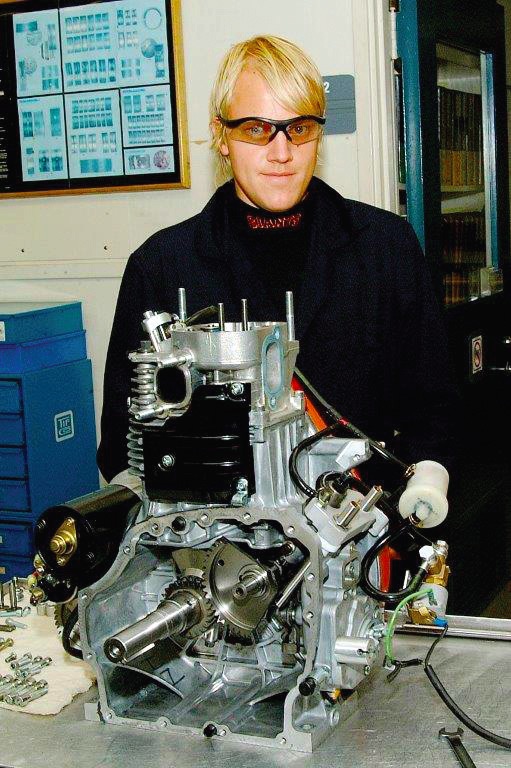 James Booth’s Chevron internship in 2005 where he explored the feasibility of using electrostatic sensors to monitor value train wear of a single cylinder engine.
TLT: How did your tribology doctorate from the University of Southampton lead to roles with Chevron?
James Booth’s Chevron internship in 2005 where he explored the feasibility of using electrostatic sensors to monitor value train wear of a single cylinder engine.
TLT: How did your tribology doctorate from the University of Southampton lead to roles with Chevron?
Booth: Before I could even tackle demystifying additive chemistry interactions and their resulting tribofilms from physical and/or chemical adsorption, the first problem I had to solve was a funding one. The lubricants company that sponsored the internship was to sponsor my doctorate but then decided not to. Meanwhile, some innovative chemists at Chevron Oronite were scouring adjacent scientific fields to inform additive development. I volunteered for the consultancy work they had commissioned. This led to follow-up projects. While consultancy work ensures what you are doing is relevant and time-managed, the watchpoint is ensuring that projects are not discrete but collectively weave together to advance the field, as expected of a doctorate.
During the first project, I wanted to ensure my work was relevant and learn from some wickedly smart people. However, when I would review results with Ken Nelson, a super sharp chemist at Chevron Oronite, and my industrial supervisor, I’d get lost—literally after two sentences. It became clear I needed to spend more time with Ken and his colleagues to address deficiencies in my knowledge and ensure I was doing work to benefit them. Richmond, Calif.-based internships were the answer. I did two of these, plus multiple trips to present results, and they formed the majority of the content for my doctorate and more.
I feel Chevron told me too much information to release me to the world, so they offered me a job! I saw how much more I could accomplish with the resources Chevron had, and I was enamored with the collaborative, respectful and consensus-driven culture. While I originally had my heart set on working for an original equipment manufacturer (OEM), I saw that lubrication fundamentals offered a window into powertrain design, and not only one OEM but many that Chevron had built relationships with.
I started as a tribologist supporting the automotive product line by conducting fundamental research and failure analysis to inform formulating for wear control. I was attracted to the thrill of placing up to a quarter of a million-dollar engine test “bets” and awaiting the outcome! I realized I knew I was addressing an important part of the formulating problem, yet there were many other performance areas for which to solve and evaluate formulation choices. Often my suggestions for wear control would be rejected by formulators because of detriments in other performance areas. I wanted to expand my horizon and felt my tribology experience had served me well in managing complexity, and I was ready to take on more. As a formulator, I spent a lot of money and had even more fun.
I grew a strong appreciation for the commercial context in which we developed lubricant technology, realizing this was yet another dimension to the formulating puzzle, only it was one with both black and white conditions like ROI, but also gray areas such as market distribution and customer messaging. This led me to a position managing a team responsible for technology deployment, and then to the commercial sector manager position for Chevron Lubricants, where I was responsible for the heavy-duty lubricants marketing plan in North America. It was in this position that I was schooled by end-users of lubricants on the importance of understanding customer value drivers and aligning product value proposition with these. At the heart of the value proposition is often translating technical performance to business benefits. It is for this reason Chevron Lubricants requires sales reps to obtain their STLE Certified Lubrication Specialist™ (CLS) or Certified Oil Monitoring Analyst™ (OMA) certification. I was fortunate to lead a project team in which we developed an award-winning mobile exhibit to educate attendees on the application of lubrication technology. At the heart of the success was a focus on customer needs and delivering technical information clearly via innovative formats.
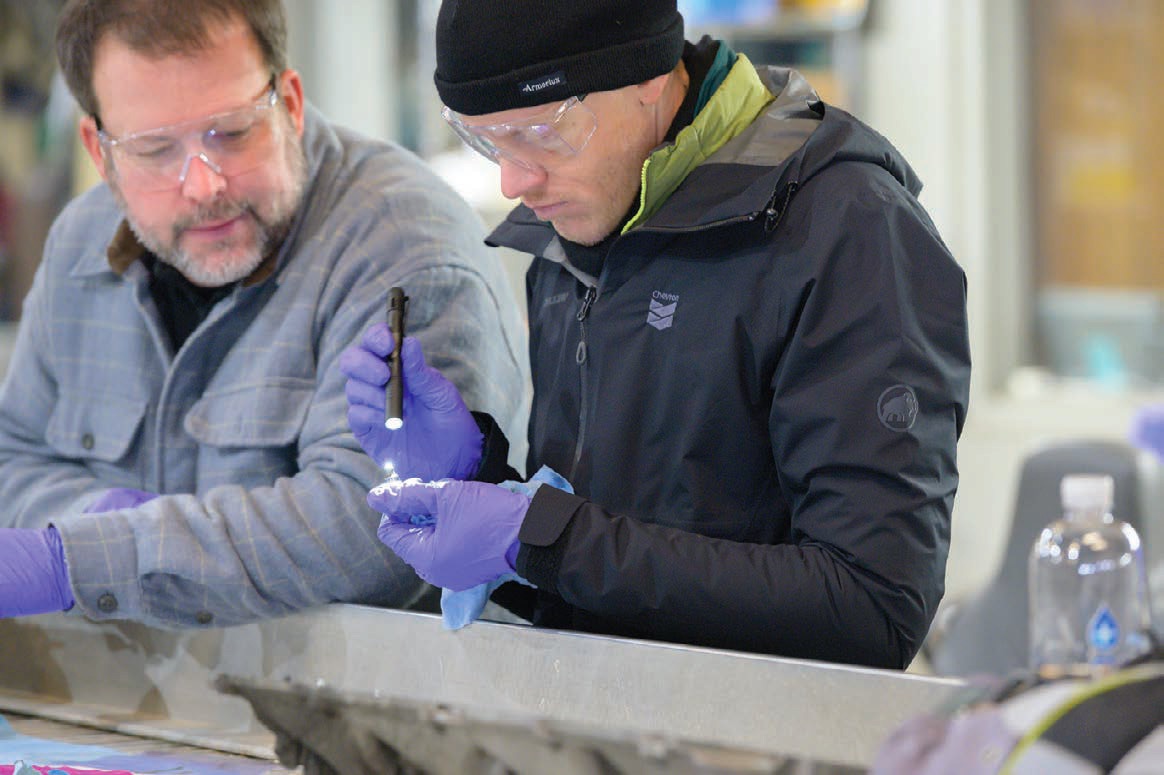
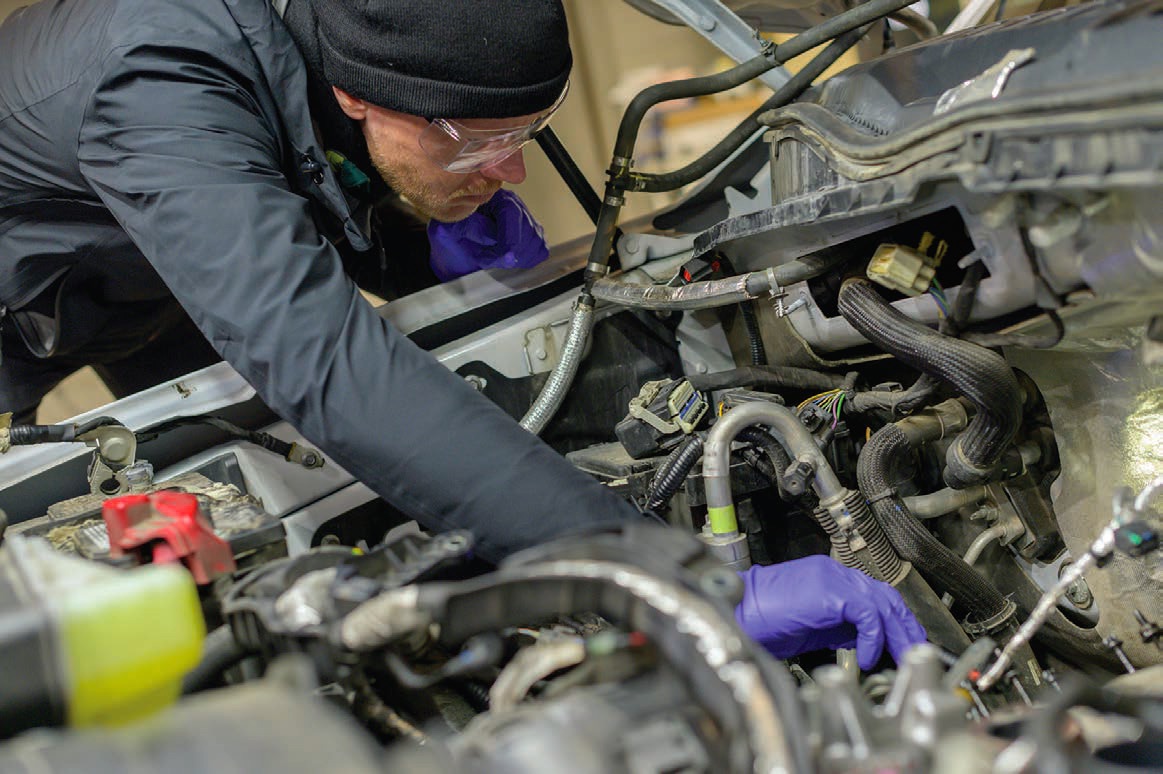 Field test inspection in the depths of winter in Detroit, Mich.
TLT: Were there benefits from your tribology education and experience that you took into your formulator position?
Field test inspection in the depths of winter in Detroit, Mich.
TLT: Were there benefits from your tribology education and experience that you took into your formulator position?
Booth: The one word is diversity. Today’s ubiquitous use of the word risks diminishing the significance. Tribology teaches the value of diverse information, expertise from diverse scientific fields and thought diversity from the wide range of cultures tribology attracts.
Solving tribology problems requires identification and sourcing of cross-functional information, and that information can take a range of forms from theoretical to experimental with differing levels of certainty. It requires leveraging cross-functional expertise to analyze complex information to bring insight and solve real-world problems.
And how do you leverage cross-functional expertise to solve problems, and make the impact known to a diverse set of stakeholders? Communication. OK, by now you may think I am playing resume buzzword bingo, but I am steadfast in its importance. Let me tell you, as someone who is dyslexic and did physics, math and art A-levels, in part to avoid having to do much writing, communication is an undeniable skill to master, especially as a tribologist. To be successful, one needs to be able to connect with mechanical engineers, chemists, chemical engineers, material scientists, spectroscopists and statisticians.
You have never seen so much red line through text as that appeared on my first-draft abstract. I was fortunate to be supervised by professor Robert Wood, who authored a proposal that received an Engineering and Physical Sciences Research Council Science & Innovation Award in 2008 to create the National Centre for Advanced Tribology at Southampton.
Let me tell you a dirty little secret. Results don’t speak for themselves. As custodian of the results and the insight thereof, you owe it to the field and yourself to ensure it reaches the people where it is going to have the greatest impact. That is true for the academic community, for business and for communicating with consumers.
Communication isn’t just written and verbal. Early in my career, the biggest complement I got from a hard-to-please formulator was that I brought color to spreadsheets (conditional formatting). The art of visual storytelling is a passion I have taken into technical and marketing roles.
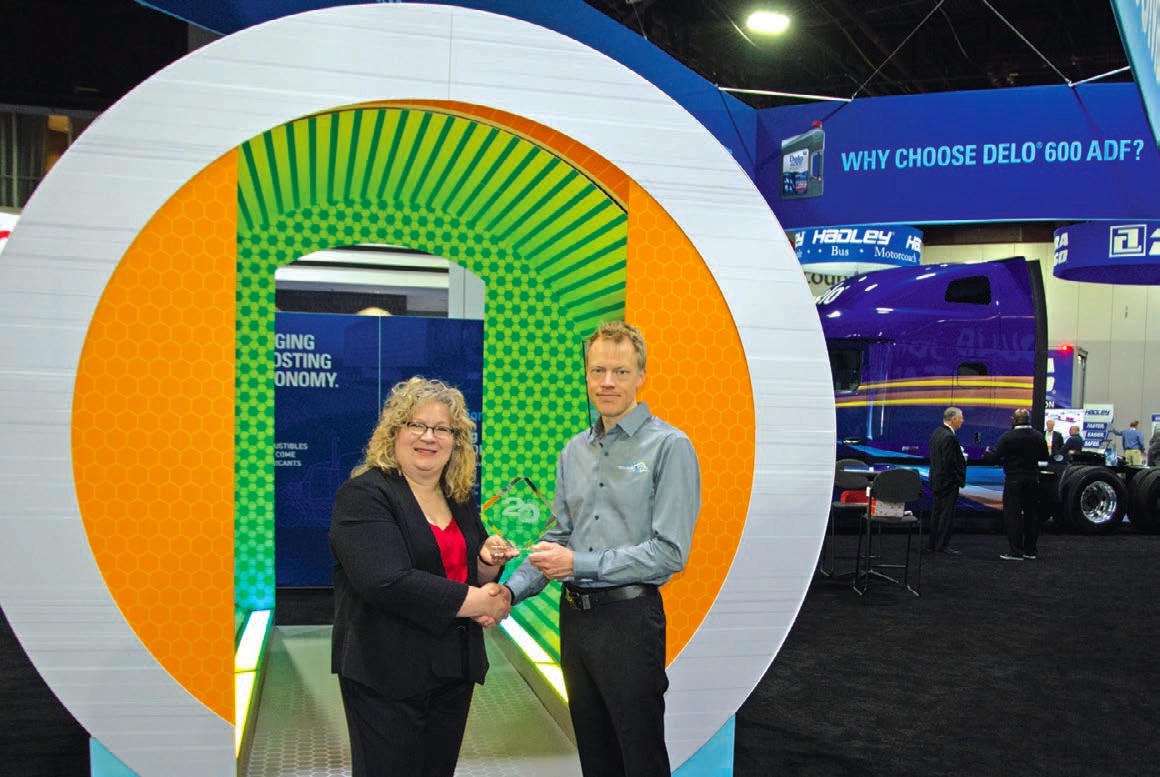 James Booth accepting an award, on behalf of Chevron, as one of Top 20 Products for 2020 by Heavy Duty Trucking.
TLT: What advice do you have for those starting a career in tribology?
James Booth accepting an award, on behalf of Chevron, as one of Top 20 Products for 2020 by Heavy Duty Trucking.
TLT: What advice do you have for those starting a career in tribology?
Booth: I’d like to address those thinking about starting a career in tribology and reassure those who have started. With the rapid pace of change experienced today, it is daunting for those at the onset of their career to decide which field will be relevant in 10 or 40 years. I see the value that feeds the staying power of a career in tribology as follows.
While digitization and energy transition are unmistakable macro shifts, the world will still require the application of tribology to advance. Tomorrow’s mechanisms/technologies may look very different from today; yet, future technologies will not exist without the knowledge underpinning of interacting surfaces in relative motion at the macro, micro and molecular scale.
Problems have become even more complex, due to speed of change, interconnected global market and level of technology sophistication that our modern world has created. Solving these problems can only be done by cross-functional teams. The field of tribology has a culture of appreciating and nurturing cross-functional expertise.
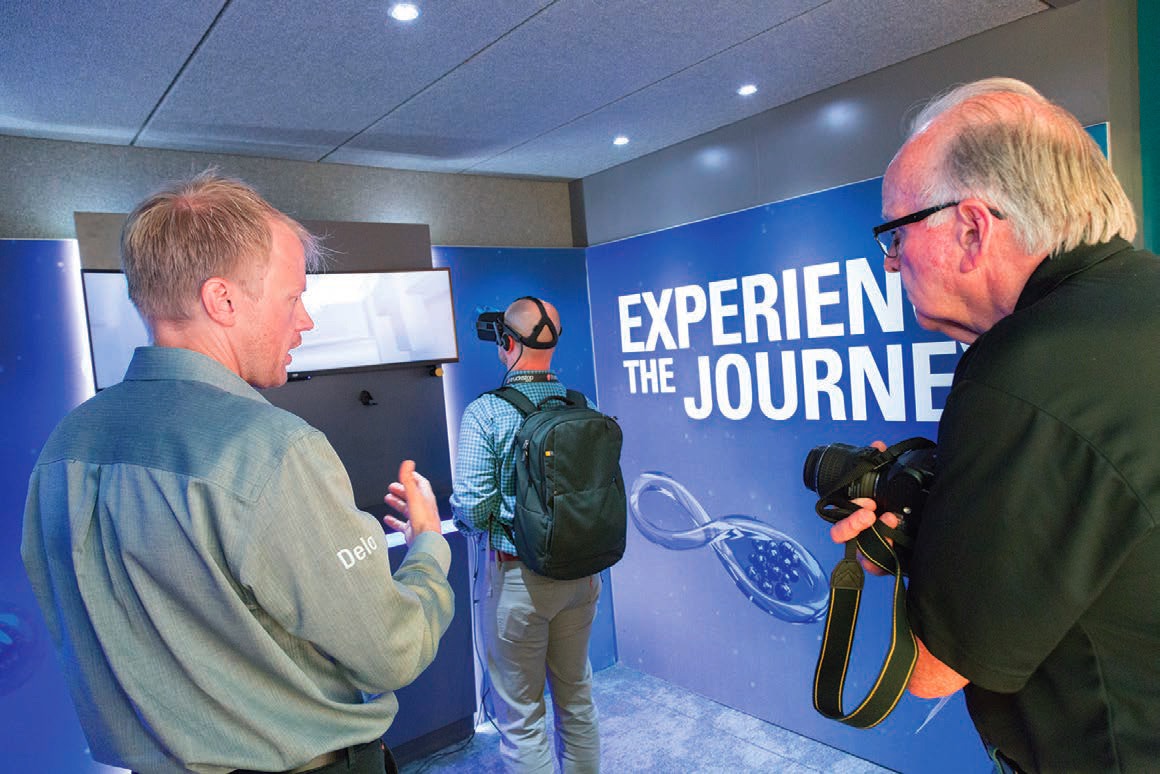 Inside the award-winning Delo® Traveling Technology Lab, a mobile exhibit sharing information on the application of lubricants via unique messaging and engaging formats.
Inside the award-winning Delo® Traveling Technology Lab, a mobile exhibit sharing information on the application of lubricants via unique messaging and engaging formats.
As a tribologist, you need to be able to connect with people verbally, through written word and visually. Successfully connecting with people is critical for aligning and inspiring cross-functional teams on an idea and why they should help you, and in making sure your results get to the people to whom they matter most. Information overload will only continue in our complex world—to be successful, one needs to cut through the noise.
Stay relevant, but have your own voice. Don’t lose sight of the end-use application of tribology. How are you going to stand out? Is it novelty in the approach and information, or is it the unique aggregation of cross-specialism information to bring insights?
Be curious. Decide where you want to push your knowledge and skill boundaries, and decide who you can inspire to leverage their expertise.
You can reach James Booth at james.booth@chevron.com.